The post A Rose Story Part 1: How I Came to Roses appeared first on Floret Flowers.
]]>I am so thankful to have gotten a chance to know her and am so inspired by how fully and generously she lived her life.
 This story is a long one, so we decided to break it up into four parts. The first part is about how I came to know Anne and the creation of our rose garden.
This story is a long one, so we decided to break it up into four parts. The first part is about how I came to know Anne and the creation of our rose garden.
The second part is about how we’re helping to preserve her extraordinary collection of roses and the process we used to propagate some of her rare treasures.
In the third part, I share more about our rose collection here on the farm and my sources for rare, hard-to-find varieties.
And the fourth part is a wonderful interview with Anne which will leave you in tears—she was one of the most inspiring women I’ve ever met. I hope you enjoy this series.
 I have been collecting rare, heirloom varieties of roses for nearly 20 years now. Shortly after we bought our house in the country, I went to work trying to transform our acre of perfectly manicured lawn into a wild, magical secret garden inspired by all of the English gardening books that I checked out at the library.
I have been collecting rare, heirloom varieties of roses for nearly 20 years now. Shortly after we bought our house in the country, I went to work trying to transform our acre of perfectly manicured lawn into a wild, magical secret garden inspired by all of the English gardening books that I checked out at the library.
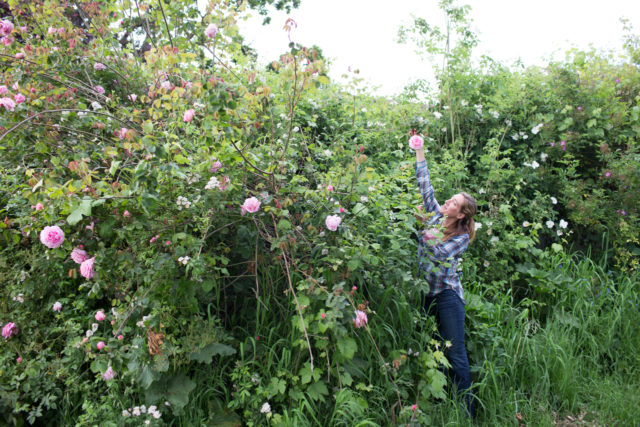
 A few years into my gardening journey, I became a full-fledged flower farmer and received my first grant to trial a wide range of roses that were known to have really great rose hips suitable for cutting. Some of the varieties were from here in the states, but many had to be imported from abroad, which was a very complicated, time-consuming, and expensive process.
A few years into my gardening journey, I became a full-fledged flower farmer and received my first grant to trial a wide range of roses that were known to have really great rose hips suitable for cutting. Some of the varieties were from here in the states, but many had to be imported from abroad, which was a very complicated, time-consuming, and expensive process.
Our area USDA plant inspector connected me with a local rosarian who was very experienced when it came to the process of importing and she generously offered to walk me through all of the steps and show me her setup for quarantining plants once they arrived in the states. And that’s how I came to know Anne Belovich.
 Anne is somewhat of a legend in the rose world and has inspired so many with her passion and generous sharing. Her love of roses was contagious and while she came to gardening later in life (she grew her first rose at 60), she scoured the globe and amassed the largest collection of giant rambling roses in North America and ended up writing five books on the subject.
Anne is somewhat of a legend in the rose world and has inspired so many with her passion and generous sharing. Her love of roses was contagious and while she came to gardening later in life (she grew her first rose at 60), she scoured the globe and amassed the largest collection of giant rambling roses in North America and ended up writing five books on the subject.

 I’ll never forget the first time I visited her garden, which was like stepping into another world. Anne and her husband Max were such warm hosts and gave me an afternoon of their time, walking me through all of the beautiful gardens and dozens of arbors smothered in arching canes of roses that were just about to bloom.
I’ll never forget the first time I visited her garden, which was like stepping into another world. Anne and her husband Max were such warm hosts and gave me an afternoon of their time, walking me through all of the beautiful gardens and dozens of arbors smothered in arching canes of roses that were just about to bloom.
Every time I thought we were at the end of the tour, we would turn a corner into another section of the garden brimming with varieties I had only read about in books.
After that first visit, Anne gave me permission to come back as often as I wanted and I returned a couple more times that season to wander around and soak in all of the magic. It was an absolute sight to behold.
I got so caught up with the farm and raising the kids and trying to keep my head above water that I lost touch with Anne, but every June when all the old roses would bloom in my garden, I would think of her and long to go back.

 Fast forward a dozen or so years and we finally had a larger piece of land to call our own. When we got the farm it was a blank slate of a field without any structure. It was hard to imagine what it could become, but one of the things I knew I wanted it to include was a rose garden—and to fill the farm with as many rare and heirloom varieties as I could possibly get my hands on.
Fast forward a dozen or so years and we finally had a larger piece of land to call our own. When we got the farm it was a blank slate of a field without any structure. It was hard to imagine what it could become, but one of the things I knew I wanted it to include was a rose garden—and to fill the farm with as many rare and heirloom varieties as I could possibly get my hands on.
So I went to work collecting plants from a wide range of nurseries and specialty growers across the country. In all, I gathered more than 250 individual varieties and nearly 1,000 plants.

 Once I had all of the plants gathered, Becky Crowley (who came from England to help me design the farm) and I got to work mapping out where they would all go. In England, there are so many spectacular gardens to visit where you can draw inspiration from. But here on the West Coast, established gardens are few and far between, and finding any with old-fashioned roses is a rare treat.
Once I had all of the plants gathered, Becky Crowley (who came from England to help me design the farm) and I got to work mapping out where they would all go. In England, there are so many spectacular gardens to visit where you can draw inspiration from. But here on the West Coast, established gardens are few and far between, and finding any with old-fashioned roses is a rare treat.
We spent a great deal of time at my favorite local nursery, Christianson’s, and the owners John and Toni were generous enough to let us tour their personal garden too. Both the nursery and their home garden were incredibly inspiring. It was during one of our conversations that Anne Belovich came up and I decided to reach out and see if we could pay her a visit.
 Many years had passed since we last spoke, but Anne, now in her late 90s, was still just as wonderful as I had remembered.
Many years had passed since we last spoke, but Anne, now in her late 90s, was still just as wonderful as I had remembered.
While she didn’t have the energy to personally take us around the garden, her lovely family gave the ladies and me a tour and then turned us loose with our clippers and notebooks to cut as many roses as we possibly could.
 The last time I visited, the extensive gardens and grounds were perfectly manicured. The beds were edged and mulched, the roses were trained to their beautiful arbors and arches, and the acres of lawn were freshly mowed.
The last time I visited, the extensive gardens and grounds were perfectly manicured. The beds were edged and mulched, the roses were trained to their beautiful arbors and arches, and the acres of lawn were freshly mowed.
But in the years since, Max had passed away and Anne was no longer able to keep up with the monumental task of maintaining the gardens alone.

 While still a sight to behold, nature had crept in and the once-perfect garden had become wild. Roses were climbing high up into the trees, they had swallowed fences and small buildings and completely smothered their arbors.
While still a sight to behold, nature had crept in and the once-perfect garden had become wild. Roses were climbing high up into the trees, they had swallowed fences and small buildings and completely smothered their arbors.
At their feet, blackberries had taken hold and the two were competing for the same space.
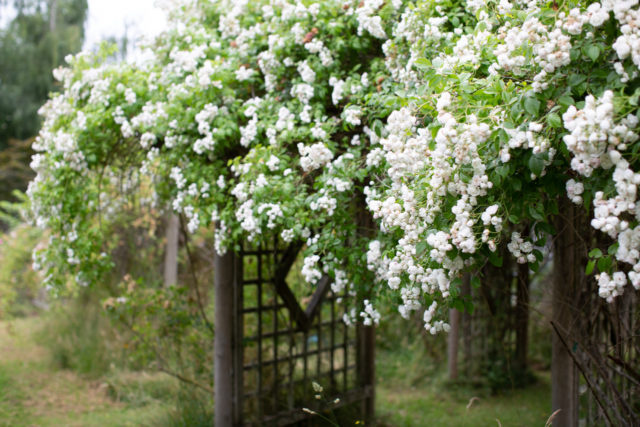
 After our tour, we were all absolutely overwhelmed by the wild beauty and the magnitude of Anne’s collection and couldn’t figure out where to even begin.
After our tour, we were all absolutely overwhelmed by the wild beauty and the magnitude of Anne’s collection and couldn’t figure out where to even begin.
So we decided to head back home and get some rest, collect our thoughts, gather supplies, and return the next morning to get to work.
 Anne’s daughter-in-law, Teddie, gave us a copy of Anne’s 20+ page rose list that included every variety on the property and its rough location. The tricky thing was that the location names were Anne’s shorthand and we weren’t sure which part of the gardens they referred to and Anne couldn’t quite remember what was where.
Anne’s daughter-in-law, Teddie, gave us a copy of Anne’s 20+ page rose list that included every variety on the property and its rough location. The tricky thing was that the location names were Anne’s shorthand and we weren’t sure which part of the gardens they referred to and Anne couldn’t quite remember what was where.
We were able to locate plastic labels on a number of varieties but many had faded and were illegible or were brittle and crumbled in our hands.

 So we spent a couple of days trying to match the rose list to the varieties that did have labels and solve the mysteries through the process of elimination and a lot of Google searching.
So we spent a couple of days trying to match the rose list to the varieties that did have labels and solve the mysteries through the process of elimination and a lot of Google searching.
We tried our best to ID and relabel as many of the roses as we possibly could, but there were still so many that remained a mystery.

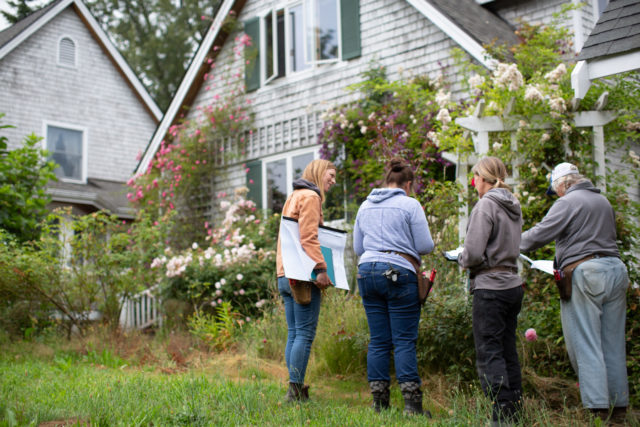
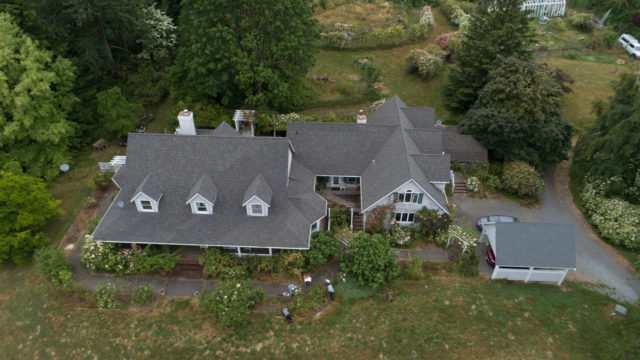 Our little team was buzzing with excitement and everyone took a different part of the project.
Our little team was buzzing with excitement and everyone took a different part of the project.
Chris took photographs and drone footage of the property so we could try and establish landmarks and key spots while Becky sketched out all of the beds, fences, and structures noting each variety that we were able to identify to ultimately pair up with the photographs so we could create an actual map.
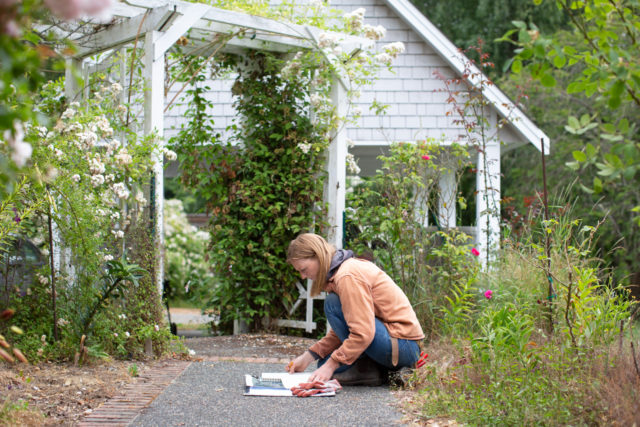

 Nina was on blackberry patrol and cut pathways through the brambles so we could get at the roses. Jill took labeling very seriously and got to the base of the plants by any means necessary.
Nina was on blackberry patrol and cut pathways through the brambles so we could get at the roses. Jill took labeling very seriously and got to the base of the plants by any means necessary.
 Angela carefully bundled each variety and got them into water and into the shade of the van. I ran around like a crazy person taking hundreds of cuttings and trying to help ID all of the mysteries.
Angela carefully bundled each variety and got them into water and into the shade of the van. I ran around like a crazy person taking hundreds of cuttings and trying to help ID all of the mysteries.
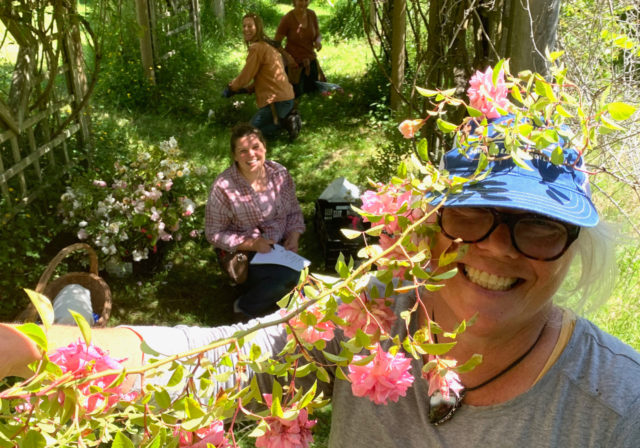 We had to keep stopping and reminding each other to breathe because we were so freaking excited about the roses and still in shock that we were even allowed into this magical secret world that Anne had created.
We had to keep stopping and reminding each other to breathe because we were so freaking excited about the roses and still in shock that we were even allowed into this magical secret world that Anne had created.

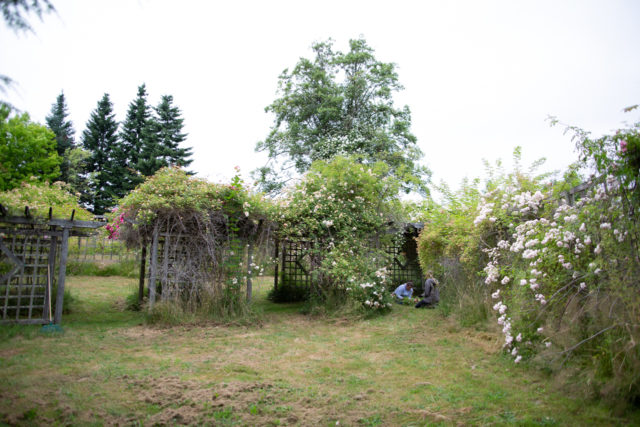 We returned three more times to gather as much cutting material as we could, but a record heatwave condensed the bloom window, which is usually about a month, into 10 short days.
We returned three more times to gather as much cutting material as we could, but a record heatwave condensed the bloom window, which is usually about a month, into 10 short days.

 I’m still in awe of how much progress we made in such a short amount of time. In all, we gathered more than 1,000 cuttings from Anne’s roses in hopes of propagating them to grow at the farm and eventually to share some of the most rare varieties with others.
I’m still in awe of how much progress we made in such a short amount of time. In all, we gathered more than 1,000 cuttings from Anne’s roses in hopes of propagating them to grow at the farm and eventually to share some of the most rare varieties with others.

 In the next post, I’ll share our process for propagating old roses through cuttings.
In the next post, I’ll share our process for propagating old roses through cuttings.
Please note: If your comment doesn’t show up right away, sit tight; we have a spam filter that requires us to approve comments before they are published.
The post A Rose Story Part 1: How I Came to Roses appeared first on Floret Flowers.
]]>The post A Rose Story Part 2: Propagating Old Roses appeared first on Floret Flowers.
]]>Own root roses, while they are harder to find, are heartier, healthier, and have a longer life. When you order them from specialty nurseries they are shipped in pots versus bare root like these pictured below.
The nice thing about old rose varieties is that they are no longer protected by plant patents and can be propagated legally.
 Many modern roses like hybrid teas, floribundas, and many of the newer David Austin varieties are typically propagated through a process of grafting or budding where licensed growers who have permission to propagate patented varieties take plant material from the variety that they want and graft it onto a rootstock.
Many modern roses like hybrid teas, floribundas, and many of the newer David Austin varieties are typically propagated through a process of grafting or budding where licensed growers who have permission to propagate patented varieties take plant material from the variety that they want and graft it onto a rootstock.
This process allows rose growers to produce them quickly, efficiently, and on a large commercial scale. These are large, bare root grafted roses, and the first ones I planted in the cutting garden.

 In my experience, the downside to grafted roses is that they are just not as hardy overall. If they experience extreme cold temperatures, the top half of a grafted variety will die and the rootstock will live on which you won’t realize until the following season when it flowers with an ugly magenta/red single bloom! If a non-grafted (own root) rose is killed to the ground it will grow back true to type which is great for gardeners in colder climates. In my experience, I’ve found that own root plants overall are healthier and longer lived.
In my experience, the downside to grafted roses is that they are just not as hardy overall. If they experience extreme cold temperatures, the top half of a grafted variety will die and the rootstock will live on which you won’t realize until the following season when it flowers with an ugly magenta/red single bloom! If a non-grafted (own root) rose is killed to the ground it will grow back true to type which is great for gardeners in colder climates. In my experience, I’ve found that own root plants overall are healthier and longer lived.
While I prefer growing own root roses, it’s certainly not required, and I still have quite a few grafted varieties in my garden that are growing wonderfully. But if given the choice, I prefer to buy own root when they are available.
 It is important to note that it is illegal to propagate patented varieties. Rose patents last for around 20 years so if there’s a variety that you’re considering propagating, you’ll want to be sure that at least 20 years have passed.
It is important to note that it is illegal to propagate patented varieties. Rose patents last for around 20 years so if there’s a variety that you’re considering propagating, you’ll want to be sure that at least 20 years have passed.
Here’s a great article about how to know which varieties of roses are protected by plant patents and which ones you can propagate freely.
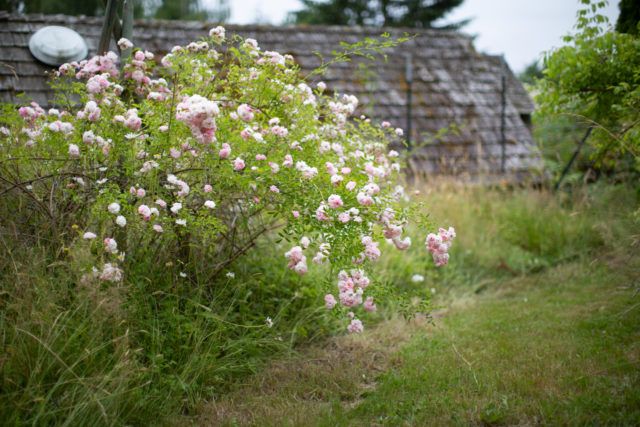 I’m not an expert when it comes to propagating roses through cuttings, but I’ve had decent success over the years.
I’m not an expert when it comes to propagating roses through cuttings, but I’ve had decent success over the years.
There is so much conflicting advice out there and it can be super overwhelming when you start researching the different methods—there are so many ways you can do it.
 For me when it comes to propagating plants of any kind, especially roses, it’s a numbers game. I take as many cuttings as I possibly can knowing that many of them won’t make it.
For me when it comes to propagating plants of any kind, especially roses, it’s a numbers game. I take as many cuttings as I possibly can knowing that many of them won’t make it.
So the more I do, the more chances I have to get it right.
 After realizing that we would be able to take cuttings from Anne’s collection, which was an unexpected surprise, I wanted to do everything in my power to ensure that we had the highest success rate for this project possible so I reached out to Burling Leong at Burlington Roses (one of my favorite sources for rare and heirloom varieties), who generously shared her expertise.
After realizing that we would be able to take cuttings from Anne’s collection, which was an unexpected surprise, I wanted to do everything in my power to ensure that we had the highest success rate for this project possible so I reached out to Burling Leong at Burlington Roses (one of my favorite sources for rare and heirloom varieties), who generously shared her expertise.
 Burling recommended that we set up a misting system with a fine fog nozzle so that the cuttings could get good airflow but also adequate moisture.
Burling recommended that we set up a misting system with a fine fog nozzle so that the cuttings could get good airflow but also adequate moisture.
She recommended a blend of two-thirds perlite and one-third peat moss or coco coir and using 50- or 72-cell trays rather than pots because they don’t require as much soil or space and we had a lot of cuttings to do.
Per her advice, I switched from a liquid rooting hormone to a powdered version called Hormex which was really easy to use.

 To prepare the cell trays we mixed the perlite and peat together, wetted it down, and filled the trays with the mix, tamping them down on the table to remove any air pockets.
To prepare the cell trays we mixed the perlite and peat together, wetted it down, and filled the trays with the mix, tamping them down on the table to remove any air pockets.
Then Jill went through with a pencil and pre-poked holes in the center of each cell until it hit the bottom of the tray. Then the trays were ready to receive the cuttings.

 When we were at Anne’s we cut roughly 12-in pieces of rose canes (that were the thickness of a pencil) off of the plants, bundled them by variety, and transported them from her garden to our farm in jars of water.
When we were at Anne’s we cut roughly 12-in pieces of rose canes (that were the thickness of a pencil) off of the plants, bundled them by variety, and transported them from her garden to our farm in jars of water.
 As soon as we got back to the farm we processed the cuttings by cutting each long cane down into smaller pieces that had at least three internodes (leaves) per section.
As soon as we got back to the farm we processed the cuttings by cutting each long cane down into smaller pieces that had at least three internodes (leaves) per section.
We then removed the lower leaves, typically leaving one set of leaves at the top of the stem if they weren’t wilted from the journey.
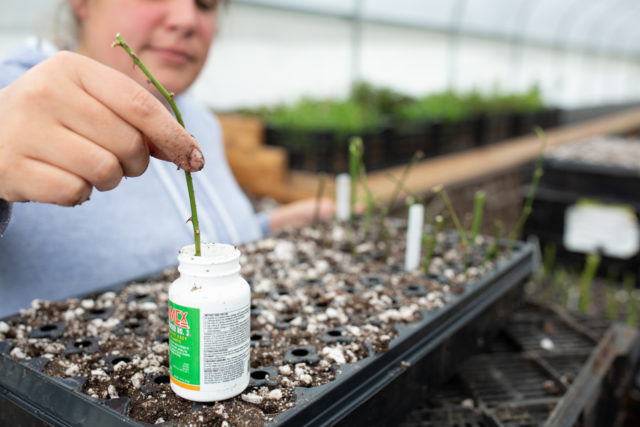
 Next, we dipped the stem end into the rooting powder and slipped them down through the pre-poked holes in the cell tray, and gently firmed the soil around the stem.
Next, we dipped the stem end into the rooting powder and slipped them down through the pre-poked holes in the cell tray, and gently firmed the soil around the stem.
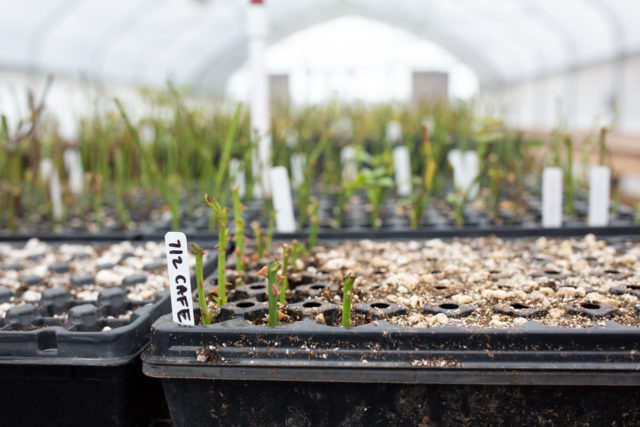
 Once the trays were filled with cuttings, they were labeled with the variety name and date and set under the misters, which came on for a few minutes every hour during the day.
Once the trays were filled with cuttings, they were labeled with the variety name and date and set under the misters, which came on for a few minutes every hour during the day.
Then the hard part began … waiting to see if it worked.

 Generally, cuttings take 4 to 6 weeks to root, sometimes longer depending on the variety.
Generally, cuttings take 4 to 6 weeks to root, sometimes longer depending on the variety.
Once we saw white roots start to form and poke out the bottom of the cell tray, we then very gently transplanted them into larger pots so they had room to spread out.
 These tender little cuttings will spend the winter inside the greenhouse (which is kept just above freezing) and then they will be transplanted again into larger pots in the spring once they start putting on new growth.
These tender little cuttings will spend the winter inside the greenhouse (which is kept just above freezing) and then they will be transplanted again into larger pots in the spring once they start putting on new growth.
I’m guessing we’ll grow them in pots for at least a year before planting them into the garden just to be sure that they have the best chance of survival.
 If you are a rose-cutting expert and have any advice or tricks to share, I’d love to hear them in the comments section below.
If you are a rose-cutting expert and have any advice or tricks to share, I’d love to hear them in the comments section below.
In the next post, I’ll be sharing my favorite specialty rose nurseries here in the States plus a little more about how we’ve planted roses here on the farm.
Please note: If your comment doesn’t show up right away, sit tight; we have a spam filter that requires us to approve comments before they are published.
The post A Rose Story Part 2: Propagating Old Roses appeared first on Floret Flowers.
]]>The post A Rose Story Part 3: Floret’s Rose Collection appeared first on Floret Flowers.
]]>I had ramblers and climbers scrambling up and over my little flower studio and a few dozen heirloom treasures tucked up against the fence and on my back porch but that’s all that I could manage to squeeze in without impacting cut flower production.
 The day we signed papers for the new farm all I could think about was how long I had waited to be able to put down roots and be able to bring my garden dreams to life. One of the first things I did was start to collect roses for the future garden.
The day we signed papers for the new farm all I could think about was how long I had waited to be able to put down roots and be able to bring my garden dreams to life. One of the first things I did was start to collect roses for the future garden.

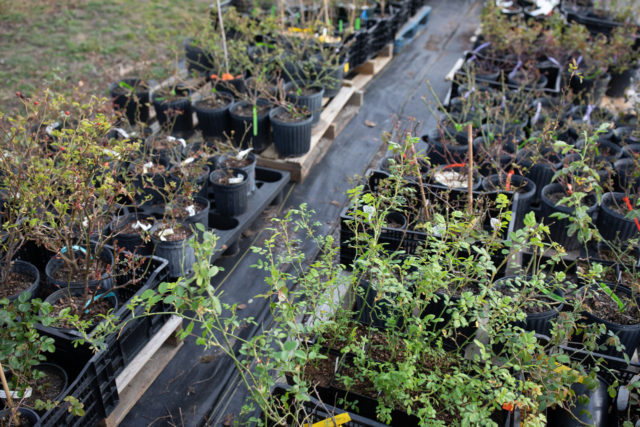 I scoured the country looking for rare, heirloom, and old-fashioned roses to include on the property. So many of the specialty nurseries that used to be in business have since closed so it was quite the task to source everything on my wish list.
I scoured the country looking for rare, heirloom, and old-fashioned roses to include on the property. So many of the specialty nurseries that used to be in business have since closed so it was quite the task to source everything on my wish list.
Of all the nurseries I’ve ordered from for this project, below you’ll find my very favorite sources.

 The Antique Rose Emporium
The Antique Rose Emporium
This long-standing Texas-based nursery has some of the best customer service around. They have a very unique offering that features more than 350 rare and hard-to-find antique varieties, including their Texas Pioneer rose series, which is a line of carefree, repeat-blooming varieties with an old-world quality.
Angel Gardens
I have found some really special varieties from this Florida-based mail-order nursery and love visiting their website for the pictures alone. Angel Gardens offers more than 1,000 antique and modern roses and uses organic growing practices in their production.
Burlington Rose Nursery
Owner Burling Leong maintains a large collection of rare and hard-to-find roses and has been one of my go-to sources when trying to track down rare, coveted varieties. To get a list of her most current availability list, email BurlingtonRoses@aol.com.
Christianson’s Nursery
If you live in western Washington, this family-run nursery has a tremendous selection of potted roses (including many heirloom and hard-to-find treasures) that go on sale in January. While they don’t ship their plants, if you’re within driving distance it’s well worth the trip, and be sure to visit in June to see their English-style rose garden in full bloom—it’s a sight to behold!
David Austin Roses
If you’ve grown roses for any length of time, chances are that you’ve fallen in love with the David Austin varieties, which are known for their old-fashioned-looking blooms that come in a wide range of soft colors and are generally repeat-blooming. I have been collecting David Austin roses for years and if you ever come across some of his older varieties, be sure to snatch them up because they are no longer being commercially propagated.
The Friends of Vintage Roses
This Sebastopol, California-based nonprofit maintains one of the largest private collections of roses in the world and was originally started by Gregg Lowrey and Philip Robinson. Each year, they propagate thousands of cuttings that are sent to curators, collectors, and public gardens devoted to preserving these special plants. Twice yearly they offer the extra plants from their propagation efforts for sale to the public (local pickup only). You can find the availability list on their website. To learn more about the important work they are doing, you can read this interview with founder Gregg Lowery.
Greenmantle Nursery
This California-based nursery has assembled a comprehensive collection of own root rare and old rose varieties that they have gathered from around the world. If you’re looking for something special, be sure to check their Rose Master List, which includes so many rare treasures. Roses from Greenmantle Nursery must be reserved with a deposit made in advance and their shipping season is January through May. It’s important to note that they only communicate through the mail or by telephone.
Heirloom Roses
This rose nursery in Oregon has a tremendous selection of varieties grown on their own roots, including more than 60 David Austin varieties (many of the older ones), a huge range of historic roses, hybrid musks, and everything in between.
High Country Roses
This Colorado-based nursery has an amazing selection of own root roses. Their collection features old garden roses, cold-tolerant varieties, and modern varieties, including some of the older David Austin treasures.
Menagerie Farm & Flower
Our flower-farming friend Felicia Alvarez offers a beautiful collection of bare root roses that she has trialed over the years and are known to make excellent cut flowers. Her inventory typically sells fast, so be sure to sign up for her newsletter. Felicia also sells fresh-cut garden roses shipped to floral designers nationwide from late spring through early autumn.
A Reverence for Roses
This Florida-based nursery specializes in own root roses and has a huge selection of heritage and old garden varieties, plus so many beautiful modern roses and a large selection of hybrid musks—my favorite group!
Rogue Valley Roses
This Oregon-based nursery offers more than 1,500 unique varieties and has one of the largest selections of rare, historic, and exceptional modern roses grown on their own roots. They ship live plants to U.S. and Canadian customers year-round, and can also ship bare root plants internationally in December and January. Be sure to use their “Join wait list” feature, since many of the plants sell out fast and it’s the only way to know when they come back in stock.
If you order from Rogue Valley, you can get 10% off your order by using the code FLORETFLOWERS at checkout. This discount is only for customers in the U.S. and Canada and expires July 31, 2023.
Rose Petal Nursery
This Florida-based mail-order nursery offers a large selection of rare heritage roses which they are constantly expanding each year. If you find something special that isn’t available, be sure to use the “be notified” button and you’ll receive an email when it’s back in stock. I’ve found some real treasures here!
 After 3 years of collecting, I gathered more than 250 varieties and nearly 1,000 plants (these numbers do not include the roses from Anne), and while this seems like a lot, I still have a huge wish list of varieties that I’m searching for. I have a feeling that my rose collecting won’t slow down any time soon and they may very well end up being the subject of a book someday.
After 3 years of collecting, I gathered more than 250 varieties and nearly 1,000 plants (these numbers do not include the roses from Anne), and while this seems like a lot, I still have a huge wish list of varieties that I’m searching for. I have a feeling that my rose collecting won’t slow down any time soon and they may very well end up being the subject of a book someday.
I will definitely share more about the varieties that I chose and how they are performing once I have a little more time to get to know them. In the meantime, I’ve shared a few of my favorites below.


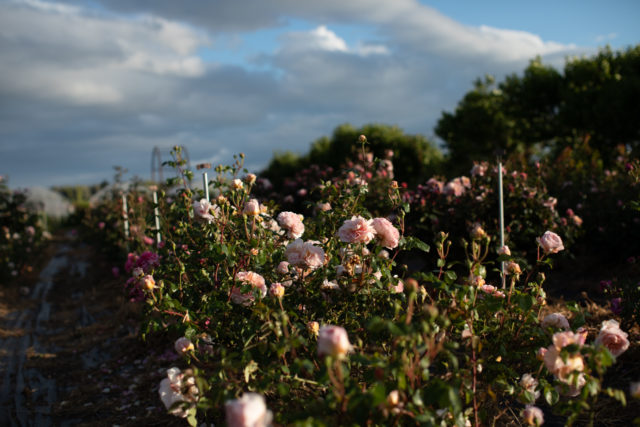 On the farm, our roses are nested into four main collections. The first are the rose varieties that we’ve planted specifically for cutting. We’ve devoted ten 70-foot rows of the cutting garden to these varieties that are organized loosely by color.
On the farm, our roses are nested into four main collections. The first are the rose varieties that we’ve planted specifically for cutting. We’ve devoted ten 70-foot rows of the cutting garden to these varieties that are organized loosely by color.
These roses are all repeat-bloomers and more than half of them are David Austin varieties and most have a full cabbage rose look.
 Some of my favorites from the cutting garden are ‘Abraham Darby’, ‘Golden Celebration’, ‘Grace’, ‘Teasing Georgia’, ‘Perlie Mae’, ‘Mother of Pearl’, and ‘French Lace’.
Some of my favorites from the cutting garden are ‘Abraham Darby’, ‘Golden Celebration’, ‘Grace’, ‘Teasing Georgia’, ‘Perlie Mae’, ‘Mother of Pearl’, and ‘French Lace’.

 The second group of roses is a mix of climbing and rambling varieties, both one-time and repeat-blooming. Down the center of the cutting garden, we have a series of archways that meet in the middle under a large metal dome that will eventually be engulfed with blooms.
The second group of roses is a mix of climbing and rambling varieties, both one-time and repeat-blooming. Down the center of the cutting garden, we have a series of archways that meet in the middle under a large metal dome that will eventually be engulfed with blooms.


 Additionally, down the main access road to the cutting garden, there are a series of alternating towers with climbing roses planted at their base which will soon climb up through and spill over the top. The cutting garden is going to be off the hook once all of these structures are covered!
Additionally, down the main access road to the cutting garden, there are a series of alternating towers with climbing roses planted at their base which will soon climb up through and spill over the top. The cutting garden is going to be off the hook once all of these structures are covered!
A few of my favorite climbing and rambling varieties are ‘Cecile Brunner’, ‘Glorie de Jon’, ‘Malvern Hills’, and ‘Alchymist’.
 The third group is all of the old roses (most are one-time blooming) that are tucked into the orchard, the hedgerows, or flank the main roadways throughout the farm.
The third group is all of the old roses (most are one-time blooming) that are tucked into the orchard, the hedgerows, or flank the main roadways throughout the farm.
The idea is that once established, these vigorous, hardy varieties will be able to withstand the harsher, more exposed conditions out on the main farm.
A few of my favorite old rose varieties are ‘Dupontii’, ‘Kathleen’, ‘Moyesii’, and rosa glauca.


 The fourth group is a mix of mainly shrub roses selected for their fragrance and delicate-looking blooms. We wanted to be able to observe these roses up close and really get to know them over time.
The fourth group is a mix of mainly shrub roses selected for their fragrance and delicate-looking blooms. We wanted to be able to observe these roses up close and really get to know them over time.
For this formal rose garden we needed to get the plants in the ground quickly because they had outgrown their pots and we were going through a pretty extreme heatwave, so rather than tilling up the grass and waiting for it to break down, we instead rented a sod lifter and prepared the garden space in a long, back-breaking weekend.

 We’d never used a sod lifter before and it’s definitely a great option if you need to remove grass from an area quickly, but if you have quack grass, it doesn’t get deep enough to remove the rhizomes so those still need to be grubbed out by hand.
We’d never used a sod lifter before and it’s definitely a great option if you need to remove grass from an area quickly, but if you have quack grass, it doesn’t get deep enough to remove the rhizomes so those still need to be grubbed out by hand.
Once the sod was cut, we rolled it up and took it back to the compost pile to decompose and then next spring, once it has broken down, we’ll return it to the garden in the form of compost.

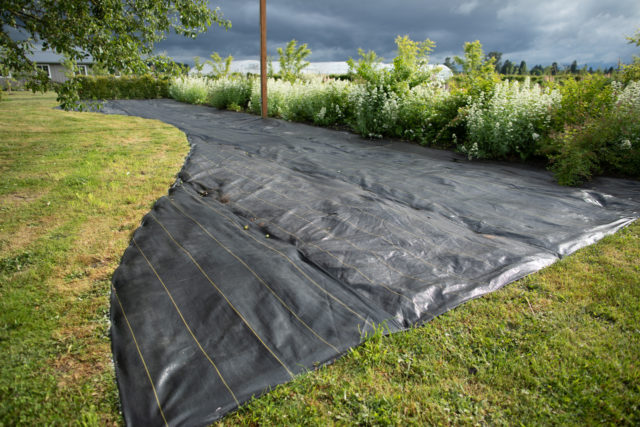 Once the sod was out of the way, we amended the planting beds with a thick layer of compost and a heavy dose of Walt’s organic fertilizer, and then covered the beds with landscape fabric. Becky then marked the spots where each rose would go, we burned holes in the fabric and planted the roses into the holes.
Once the sod was out of the way, we amended the planting beds with a thick layer of compost and a heavy dose of Walt’s organic fertilizer, and then covered the beds with landscape fabric. Becky then marked the spots where each rose would go, we burned holes in the fabric and planted the roses into the holes.
The reason for this was to help suppress the weeds in this garden while the roses grow and establish because we just didn’t have the time to mulch and weed all of the planting beds by hand. Once the roses are larger, we will remove the landscape fabric and plant perennials and small shrubs amongst the roses. I can’t wait to see this garden come to life!
Some notable favorites planted in this garden are ‘Bishop Darlington’, ‘Buff Beauty’, ‘Penelope’, ‘Sally Holmes’, ‘Star of Republic’, and ‘Windrush’.

 I’ve saved the best for last. In the fourth and final post of this series, you’ll find an interview with Anne Belovich that she so generously shared with us all this summer, just a few short months before she passed away.
I’ve saved the best for last. In the fourth and final post of this series, you’ll find an interview with Anne Belovich that she so generously shared with us all this summer, just a few short months before she passed away.
Please note: If your comment doesn’t show up right away, sit tight; we have a spam filter that requires us to approve comments before they are published.
Floret only lists companies and products that we love, use, and recommend. All opinions expressed here are our own and Floret does not offer sponsored content or accept money for editorial reviews. If you buy something using the retail links in this post, Floret may receive a small commission. Thank you for your support!
The post A Rose Story Part 3: Floret’s Rose Collection appeared first on Floret Flowers.
]]>The post A Rose Story Part 4: An Interview with Anne Belovich appeared first on Floret Flowers.
]]>I am so thankful to have gotten a chance to know her and am so inspired by how fully and generously she lived her life.

You’ve had a very full career and an even fuller life—first as a botanist, then a teacher, then a sailor, a general contractor, and then a rosarian and a writer. Can you tell me a little bit more about your very diverse life path?
I have had a very full life and while much is owed to the length of my life, my longevity, likewise, probably benefited from having a full, diverse life. Life-long learning and growing keeps one engaged.
It would probably surprise many of your readers to know that I used to consider myself a prisoner in my mother’s garden. We lived in Morro Bay on a high bluff. As a young child of three, maybe four, I used to run away—down the trail, that certainly wasn’t made for children, as fast as I could go down to the water. I’d get down there in the sand and there would be crabs and herons that would be fishing—so many wonderful things to see.
My mother would come screaming down after me, drag me back, and tell me to stay in the garden. The water is where I wanted to be and I managed to sneak out often until my mother put up THE fence. My mother had a wonderful garden considering those times and her means. It was always about nature though. My appreciation of flowers came later.
My life could have played out very differently if not for losing my first husband in World War II. He was such an amazing man—very handsome, very good to me, and talented. I ran away from home to be with him and get married. He entered the military and became a fighter pilot in the 1st Air Commando group under Colonel Cochran, with the mission of flying behind Japanese lines to supply and evacuate troops and materials as well as provide fire.
My husband completed the ‘Thursday’ mission but died shortly after because of his airplane’s mechanical failure. This left me as a 19-year-old widow and new mother who had to find her own way in life. If not for this tragedy, I would have most likely had more children and settled down into a role very different from the many I’ve had since that time.
One thing that isn’t mentioned above, but is very dear to me, are the numerous volunteer and board positions I’ve held, especially co-creator of NOAH, the Northwest Organization for Animal Help, in Stanwood, Washington, which is dedicated to ending euthanasia of healthy, adoptable, and treatable homeless dogs and cats. Our humble beginnings consisted of volunteering once a week to answer phones and match the people who had lost their animals to those who had found animals on the Island.
As a result of the ever-growing need to save more animals and serve the community, we expanded adoption and a transfer/low-cost spaying and neutering program. In coordination with over 50 other shelters, NOAH transfers animals at risk of euthanasia to continue to work on giving them a second chance. I was on the board until my husband Max needed more care to stay in our home at the end of his life. However, I still donate to this important cause and others that lessen the suffering of animals, both domestic and wild, and work to conserve biodiversity on our planet. Much more work needs to be done in these areas.
 In the introduction to Ramblers & Other Rose Species Hybrids, you say that “fortunate circumstances” led you to start a small rose garden. That small rose garden evolved into 5 acres of nearly 1,000 unique varieties (which eventually became the largest private collection in North America). Can you tell Floret readers a little bit more about this fortunate circumstance? What was it about roses in particular that put you under their spell?
In the introduction to Ramblers & Other Rose Species Hybrids, you say that “fortunate circumstances” led you to start a small rose garden. That small rose garden evolved into 5 acres of nearly 1,000 unique varieties (which eventually became the largest private collection in North America). Can you tell Floret readers a little bit more about this fortunate circumstance? What was it about roses in particular that put you under their spell?
I just love them so. I’m a very visual person and the beauty that roses bring into my world gives me great joy. The “fortunate circumstances” I referred to in my book on ramblers was that I read an advertisement about a nursery in Oregon that was going out of business and having a big sale.
The ramblers were a really good price, and I came back with a truckload of them which I put on the fences around the property. I also put some into trees by building trellises to help support their growth. There was something wonderfully mysterious about roses growing up the trellises and into the trees to make the tree look as though it was blooming.
 You’ve written five books on roses, but have a deep love of rambling roses. What do you wish others knew about this amazing group of plants and why they should consider growing them in their garden?
You’ve written five books on roses, but have a deep love of rambling roses. What do you wish others knew about this amazing group of plants and why they should consider growing them in their garden?
Ramblers are easy to grow. Once they are established, they need little care. They grow tall and are excellent for covering fences and arbors, and for growing into trees. They provide a quick and easy way to add color to the garden.
 You’ve scoured the globe for rare rose varieties. What are some of your favorite specialty nurseries? And besides your own wonderful books, do you have any other books or resources that you’d recommend for beginning and experienced rose growers?
You’ve scoured the globe for rare rose varieties. What are some of your favorite specialty nurseries? And besides your own wonderful books, do you have any other books or resources that you’d recommend for beginning and experienced rose growers?
While I have traveled the world, I like to support local, small business owners as much as possible. Their work is hard, and we have lost many nurseries, especially those that focus on old roses. Vintage Roses used to be the best but went out of business. I enjoy going to Christianson’s Nursery & Greenhouse in Mount Vernon, Washington. Two others are Hortico in Canada and Rogue Valley Roses in Oregon.
As for books, Classic Roses by Peter Beales is a very important reference book if you are serious about roses. Another one that was very helpful to me in the beginning was David Austin’s English Roses by David Austin and Michael Marriott.
 I always hate it when people ask me what my favorite flower is because there are too many treasures to choose from, but if you could only grow five roses in your garden, what would they be?
I always hate it when people ask me what my favorite flower is because there are too many treasures to choose from, but if you could only grow five roses in your garden, what would they be?
I really don’t have a favorite. All of them are so unique and bring something special with them. If I must choose one, I think it would have to be Hybrid R. Moyesii ‘Geranium’. In my book, Ramblers and Other Rose Species Hybrids, I mention that mine had grown to 10 feet (3 meters). That was in 2016. It is now running way up into the trees and spills over in a striking cascade of scarlet red in early summer. It fills the view from my dressing room window.
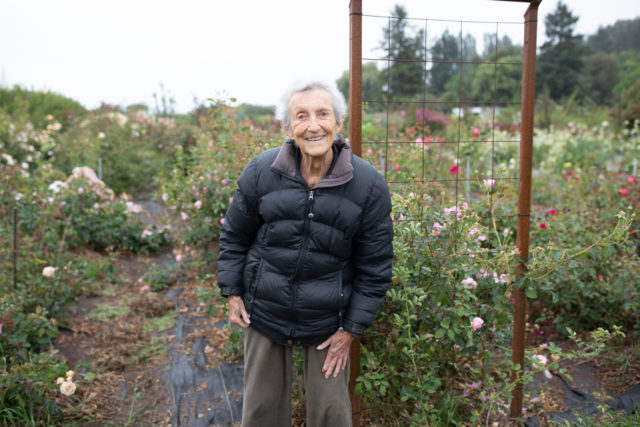
Pictured above: Anne visiting our rose garden this past summer
Your passion for roses started much later in life. Do you have any advice for someone who feels like it’s too late to pursue their dreams?
I remember when I turned 60. I thought 60 was so old. That was almost 37 years ago, well over one-third of my lifetime so far.
At almost 97 years old, it doesn’t seem that my passion for roses started all that late in life. It’s been over 30 years since I began this journey—longer than the careers of many. I pursued many dreams after turning 60, including starting my own contracting company and building over 25 (mostly Victorian style) houses, traveling the world, and my study of the older roses. It is never too late to act on your goals and dreams.
My advice is to keep moving, stay out of bed, go out to lunch and visit with friends and family (don’t isolate yourself), read and stay up to date with current events, be open to new ideas, and commit yourself to life-long learning and skill development.
In fact, I am about to launch my own website and blog. I’ve always wanted my own website and I don’t think it’s too late to do this. I bought my own domain last week.
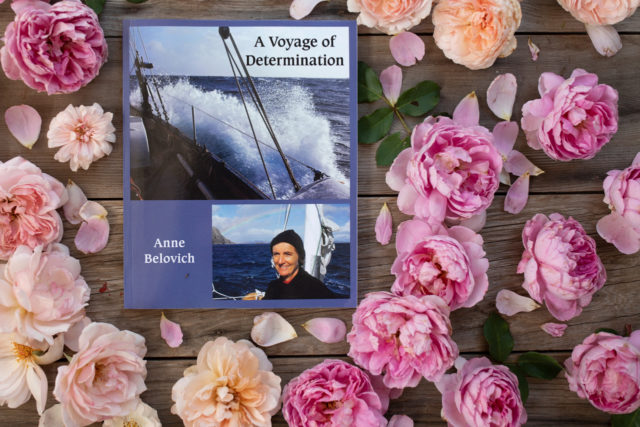 In your book, A Voyage of Determination, which chronicles your incredible adventure sailing your beloved boat from New Zealand to California, you share your formula for achieving any difficult goal, which I found incredibly inspiring as a woman who has big dreams. You write:
In your book, A Voyage of Determination, which chronicles your incredible adventure sailing your beloved boat from New Zealand to California, you share your formula for achieving any difficult goal, which I found incredibly inspiring as a woman who has big dreams. You write:
“When I was alone I spent much of my time thinking about the fantastic trip I had been privileged to experience. It was of great value to me in a way that was quite separate from getting the boat back. I had learned that I was capable of accomplishing very difficult goals. I was able to face considerable hardships and even extreme danger when it was necessary to achieve those goals. Without being quite aware of it I had developed a formula for greatly improving the chances of achieving any difficult goal. It consisted of three main parts.
First, don’t let being a woman stop you from doing what is traditionally seen as a man’s job unless you really need a constant supply of testosterone to achieve your goal. Ask yourself if the activity requires big biceps and a beard. If not, go ahead with your dreams and fight the prejudice where you find it. Look carefully for the same prejudice in yourself. It could be lurking there without you realizing it and could cause you to not believe in yourself and to restrict you from following a difficult goal. If you are a man you are not apt to encounter prejudice in life’s goals because of your gender, but if you do don’t let it stop you.
Next, you should try to know yourself, your talents, and limitations, but be careful to not underestimate what you are capable of doing. Becoming a rocket scientist will be a difficult goal if you struggle with math, but maybe some remedial instruction in math would help you overcome the problem. I learned to navigate the old-fashioned way with a sextant even though I didn’t learn my number combinations when I was a child because of constant moving and now I compute manually with difficulty.
On the other hand, you might want to pick something that comes to you more naturally. A passion for a particular hobby might be an indication of a special talent that could be pursued and turned into a rewarding career. Then, be willing to spend some time and energy preparing for what you want to do. I owe much of my success to this one.”
I put some things in the Voyage of Determination, and you have to do all of them. Determine what it is you want to do and then acquire any skills or knowledge that you are going to need, get the books, take the classes. I bought three books when I decided to build the house on Camano Island; how to frame a house, how to wire it, and how to do the plumbing. You need to study and become an apprentice.
You can do anything a man can do except those things that require a lot of strength…I think I said ‘big biceps’ in there. However, you can even figure out how to use mechanical means to overcome that. For example, I bought and used a wall jack on a house I was building to lift the walls into place all by myself.
You can meet and exceed your goals if you prepare yourself over time. You can’t become a rocket scientist without a great deal of study, and neither can anyone else.
 You have so generously shared what you’ve learned with so many and I would love to know how myself and Floret readers can support your work into the future. How do we ensure that these rare and heirloom rose varieties live on? How can we pick up the torch and help carry your legacy forward?
You have so generously shared what you’ve learned with so many and I would love to know how myself and Floret readers can support your work into the future. How do we ensure that these rare and heirloom rose varieties live on? How can we pick up the torch and help carry your legacy forward?
Keep them watered, fertilized, and in a place with lots of sunshine. Roses, especially the old roses, are very easy to grow. However, inviting people into your gardens and sharing is perhaps most important. Don’t be stingy. To inspire and introduce people to the beauty of old roses and sending cuttings of roses into their home gardens, is an act of love … of friendship. This is the greatest legacy.
Max and I used to have people over all the time to enjoy the property, and many friendships as lovely as the roses developed. I couldn’t do that for a while, but now that my son and his wife are restoring the gardens, we have been able to do this again on a very limited basis (and keeping public health recommendations in mind). It’s such a joy to see old friends again, such as you, Erin. I believe you were a young lady when I first met you. So many memories tie us all together.
I have given many roses away over the years—to individuals, nurseries, and to other special collections and demonstration gardens. Recently I was notified by Claude Graves, curator of the Chambersville rose garden in Texas and the Anne Belovich Rambler Garden there, that the American Rose Center Committee voted to begin the process of replicating my entire rambler collection in Chambersville into a new garden to be constructed at America’s Rose Garden at the ARS Headquarters in Shreveport.
It is a comfort and honor knowing that my rambler collection will be duplicated and conserved in a permanent internationally-acclaimed garden. I am grateful to Dean and Carol Oswald and Claude Graves for their dedication to and hard work on this large project. I am also grateful to my friends who have watered, fertilized, and put one of my rose cuttings in a place with lots of sunshine and continue to share cuttings with their friends, both old and new, and younger family members.
In addition, consider organizing volunteer efforts to help out in rose gardens that need extra hands. What we consider older roses now can be found in many home gardens that were started by people in their younger years. The work of weeding, fertilizing, and pruning can be satisfying but enriched by stories, expertise, cuttings, and new friendships. We will have our first pruning party in February with area-old garden rose enthusiasts and garden clubs. Consider these kinds of events in your local community.
 You can learn more about Anne on her website, where her family has begun publishing blog posts that she wrote before her passing.
You can learn more about Anne on her website, where her family has begun publishing blog posts that she wrote before her passing.
I had the opportunity to interview Anne’s daughter-in-law Teddie Mower who is now caring for her extensive collection of ramblers alongside her husband Rick, Anne’s son. In the interview, she gives an update on Anne’s roses, information for those interested in visiting the property, and how we can all help carry on Anne’s legacy.
If Anne’s story has moved you, please consider adding one of her books to your library. Proceeds from the sales of her books will help support the preservation of her rambling rose collection.
Gallica Roses by Anne Belovich
Large-Flowered Climbing Roses by Anne Belovich
The Little Book of Alba Roses by Anne Belovich
Moss Roses by Anne Belovich and Harald Enders
Ramblers and Other Rose Species Hybrids by Anne Belovich
A Voyage of Determination by Anne Belovich
 I thought it would be fun to give away Anne’s complete library of books to three lucky readers. To enter to win, please share what part of her interview inspired you the most. This giveaway is open to both U.S. and international readers. Winners will be announced here on May 30.
I thought it would be fun to give away Anne’s complete library of books to three lucky readers. To enter to win, please share what part of her interview inspired you the most. This giveaway is open to both U.S. and international readers. Winners will be announced here on May 30.
Update: A huge congratulations to our winners: Michelle, Pam Blinten and Carrie K.
Please note: If your comment doesn’t show up right away, sit tight; we have a spam filter that requires us to approve comments before they are published.
Floret only lists companies and products that we love, use, and recommend. All opinions expressed here are our own and Floret does not offer sponsored content or accept money for editorial reviews. If you buy something using the retail links in this post, Floret may receive a small commission. Thank you for your support!
The post A Rose Story Part 4: An Interview with Anne Belovich appeared first on Floret Flowers.
]]>